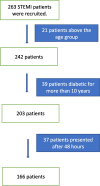Impact of health awareness on myocardial infarction
- PMID: 40140135
- PMCID: PMC11947391
- DOI: 10.1186/s42506-025-00186-y
Impact of health awareness on myocardial infarction
Abstract
Background: Health awareness plays a major role in determining the outcomes of serious medical conditions especially when response time is crucial. STEMI (ST-segment elevation myocardial infarction) patients are prone to serious compilations if they do not receive the appropriate treatment on time. Many factors affect the health awareness of the community, including educational level, previous exposure to similar situations, and exposure to health awareness materials. Those who do not know the symptoms of myocardial infarction will present late to the hospital and are exposed to a higher risk of complications. This study aims to assess the relationship between the health awareness of STEMI patients and the time of presentation to the emergency room (ER).
Methods: A cohort observational study was conducted at the National Heart Institute in Egypt gathering data on 263 STEMI patients presenting for primary percutaneous intervention. All the demographic and clinical necessary data was collected by the researchers in the emergency room, catheterization lab, and during the hospital admission of the patient. This study is a part of our larger cohort study on the relationship between education/health awareness of patients and outcomes of myocardial infarction.
Results: Data from 166 eligible patients were analyzed showing a significant correlation between health awareness and time of presentation to the ER in STEMI patients (p < 0.05). Additionally, there was a significant correlation between educational level and time of presentation to the ER (p < 0.05). The mean time from chest pain to arrival at the ER was 9.5 h. That is far beyond the range recommended internationally. Males, smokers, and younger age patients were significantly more likely to present earlier than their counterparts (p < 0.05).
Conclusions: Both educational level and health awareness of cardiac symptoms are associated with early presentation to the ER in STEMI patients. Developing health awareness activities targeting various population groups regarding cardiac symptoms and how to deal with them and including health education in different educational curricula are recommended.
Keywords: Education; Health awareness; STEMI; Time of presentation to the ER.
© 2025. The Author(s).
Conflict of interest statement
Declarations. Ethics approval and consent to participate: The study was approved by the Institutional Review Board of the General Organization of Teaching Hospitals and Institutes (GOTHI) with a registration number IHC00054 dated 7/6/2023. The study was approved by the Institutional Review Board of the American University in Cairo. Informed written consent was obtained from all subjects in the study. Consent for publication: Not applicable. Competing interests: The authors declare that they have no competing interests.
Figures
References
-
- Akbar H, Foth C, Kahloon RA, Mountfort S . Acute ST-segment elevation myocardial infarction ( STEMI ). In: StatPearls. Treasure Island (FL): StatPearls Publishing; 2024. p. 1–17. Available from: https://pubmed.ncbi.nlm.nih.gov/30335314/. Accessed 22 Jan 2025. - PubMed
-
- McDonagh TA, Metra M, Adamo M, Gardner RS, Baumbach A, Böhm M, et al. 2021 ESC Guidelines for the diagnosis and treatment of acute and chronic heart failure. Eur Heart J. 2021;42(36):3599–726. https://doi.org/0.1093/eurheartj/ehab670. - PubMed
-
- Avanthika KV, Kandathil JJ, Iype M, Anish TS. Factors affecting total ischemic time of patients with ST-elevation myocardial infarction: a cross-sectional study from a tertiary care hospital in Kerala India. JClin Prev Cardiol. 2023;12(3):86–93. 10.4103/jcpc.jcpc_9_23.
LinkOut - more resources
Full Text Sources
Miscellaneous




